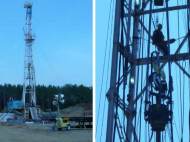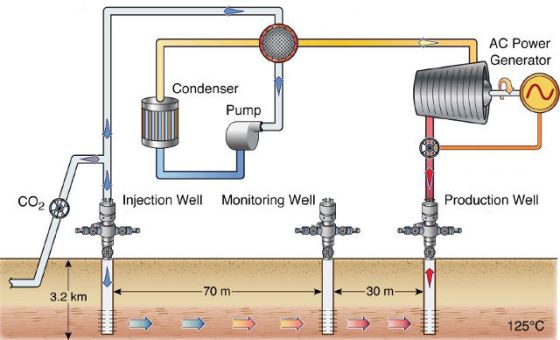Using geothermal energy to produce electricity and store CO2 underground
 A team of researchers, led by researchers from the Lawrence Berkeley National Laboratory (Berkeley Lab), hopes to become the first in the world to produce electricity from the CO2 heated by energy under the surface of the Earth. The system could also be used to permanently store some of the CO2 underground, thus reducing its impact on climate change.
A team of researchers, led by researchers from the Lawrence Berkeley National Laboratory (Berkeley Lab), hopes to become the first in the world to produce electricity from the CO2 heated by energy under the surface of the Earth. The system could also be used to permanently store some of the CO2 underground, thus reducing its impact on climate change.
The system offers a new way to employ geothermal energy in arid regions because it uses CO2 instead water. For more than a decade, researchers around the world, including Berkeley Lab, have theorized that supercritical CO2 could be used instead of water. Their work has shown that supercritical CO2 is more efficient than water when it comes to mining heat from the subsurface.
The idea is to inject CO2 three kilometers (1.86 miles) underground into a sedimentary layer which has a temperature of 125° Celsius (257° Fahrenheit). CO2 enters a supercritical state under these conditions, meaning it has both liquid and gas properties. Afterwards, CO2 is being pulled to the surface and fed into a turbine that converts heat into electricity. Next, it will loop back underground and repeats the cycle. More CO2 will be continuously added to the system to keep the turbines spinning, and the researchers expect a part of the CO2 to become permanently trapped in the sediment which will form through usage of their system.
In the first stage of the project, Echogen Power Systems will design a turbine that can handle supercritical CO2 laden with hydrocarbons and water accrue during its subsurface journey. Scientists from the University of Texas at Austin will analyze the environmental impacts of the process over its entire life span. Berkeley Lab scientists will use numerical models to predict how the reservoir will evolve over time as more and more CO2 courses through it. They’ll also determine how much energy can be extracted from the CO2 by coupling reservoir models with Echogen’s turbine models.
In the second stage, they’ll build it at the Southeast Regional Carbon Sequestration Partnership’s Cranfield site, where a Department of Energy-funded CO2 injection project has been underway since 2009. The reservoir located on site is at the desired depth and it has proven to be an ideal site for carbon capturing. Much of the infrastructure needed for the test is already in place, including injection and production wells. The CO2 will come from a pipeline operated by Texas-based Denbury Resources.
“Our approach relies on this gradual loss as a way to store a power plant’s CO2 underground rather than emitting it into the atmosphere. Our planned demonstration is the first attempt at proving that we can simultaneously mitigate greenhouse gas induced climate change and generate clean baseload power using geothermal energy”, said Barry Freifeld, a mechanical engineer in Berkeley Lab’s Earth Sciences Division who leads the project.
The researchers aren’t sure how much electricity the system can generate since it depends on the scale of carbon capture and storage operations and the availability of deep reservoirs that can both heat and store CO2. However, the capability to generate power needed for carbon storage makes it more efficient compared to other carbon storage systems whose large pumps and compressors consume a lot of power in order to capture CO2.










Great research to find alternative energy from Geothermal source with storage of Carbon Dioxide underground. Congratulations to researchers at Lawrence Berkeley National Laboratory.
Dr.A.Jagadeesh Nellore(AP),India
Wind Energy Expert
E-mail: anumakonda.jagadeesh@gmail.com